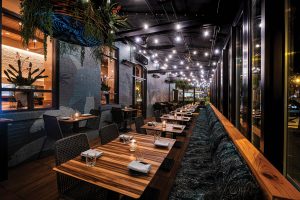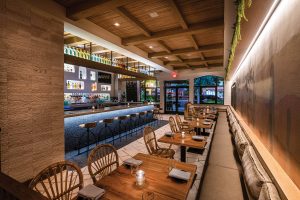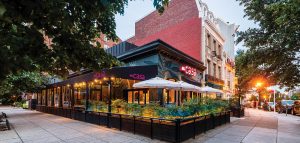— By David Tracz —
Modern restaurant design and its evolution.
If there is one common experience that (most) humans share a love for, it’s probably food — especially when that food is cooked by someone else. Enter: the restaurant industry. It’s one of the most fast-paced, efficient and timely fields that everyone plays a part in, whether as a consumer, chef, server, manager or restaurateur. If you’re looking for a sign of the times, you can usually find it reflected in the variety of restaurants lining the sidewalks. The food industry is continuously adapting and developing new solutions for the future while tackling the challenges of the present day.

David Tracz, //3877
When it comes to trends, restaurants have pivoted from creating fun craft cocktails and hosting trivia nights to implementing strategies that ensure the survival of the business. The past 2 years have highlighted the ingenuity, scrappiness and determination of the industry — qualities that existed long before 2020. As we look onward, we’ll continue to see trends evolve to meet ever-changing customer expectations. The pandemic did not only create new concepts, it also pushed many existing ideas to the forefront, and they’re likely here to stay.
QR Codes & the Customer Experience
Seen as rising stars for table service during the height of the pandemic, QR codes have the potential to impact the dining experience long term and become more integrated into restaurant processes. Rather than being utilized solely for digital menu application, we will start to see them used in a greater range of services, including taking orders and handling payments. QR codes provide the flexibility that restaurants need. Out of a dish? A simple digital edit removes it from the menu, mitigating any confusion or frustration from customers who really wanted the mozzarella sticks that ran out 45 minutes ago during the lunch hour rush.

Photo: Rey Lopez
QR codes streamline operations and allow runners and servers to focus on the customer experience. Rather than running back and forth between taking orders, submitting them to the kitchen and bringing out food, workers can pay attention to the individual experience. This can cut down on the time that people are waiting for their orders and help servers be more available to wait on guests for any needs. Servers can be more vigilant and proactive without any added stress. This meets the standard of efficiency without compromising on the real reasons people go out to eat: for a catered experience, delicious food and human connection. This gives servers the availability to establish personal connections with guests that last much longer than the mints they grab on the way out.
Defining Space through Fresh Concepts

Photo: Rey Lopez
As the industry adjusts to a new era of public spaces, many of the quick solutions implemented in March 2020 are being phased out for more long term concepts. Flexible seating is more important than ever as restaurants move away from the use of plastic dividers and drywall to define space. These elements of separation are now reflected in thoughtful, fresh furniture choices. Flexible furniture and interiors enable spaces to shift and accommodate any situation. Is high COVID-19 transmission in the area requiring more distance between diners? Utilize tables and chairs that are easily moved throughout the space, allowing for new layouts and circulation to be implemented for the benefit of staff and patrons.
Designers will stray away from using permanent dividers and will instead gravitate towards different types of seating to define dining spaces. This approach enhances flow throughout the restaurant, creates more private areas and provides the flexibility to close off spaces when not in use. Restaurants can adapt to different party sizes, events and schedules. They’re no longer bound to permanent layouts or circulations, giving them the flexibility to satisfy customers and enhance the overall performance of staff.
Indoor? Outdoor? Why Not Both?
It’s no secret that restaurants discovered the untapped power of outdoor dining amidst the pandemic. Outdoor dining has become a staple in the restaurant experience, providing diners with options that make them feel comfortable and safe. It gives patrons the much-needed and desired autonomy to control the type of experience they have.

Photo: Rey Lopez
We’ll also see more greenery incorporated in restaurant interiors; diners got a taste of enjoying the outdoors during their meal and that craving has remained. Designers are looking to bring a bit of the outdoors back inside for that natural look and energizing feel (satisfying this desire year-round). In Mi Casa, a recent project designed by KNEAD Hospitality + Design in collaboration with our team, we found ways to organically incorporate touches of green into the space. We used cacti and hanging plants to enhance the desert feel of the restaurant while adding pops of color to tie it all together.
There’s also power in embracing the outdoor dining components of operation, making it feel like a part of the restaurant rather than “another” option. Diners that choose to eat outdoors still want to feel the full experience of the restaurant environment. Permanent heaters and seating as well as operable walls, windows and roofs that protect against the elements have replaced makeshift tents from the pandemic and show that restaurants recognize the worth of prioritizing outdoor dining long term.
The resilience, passion and community of the restaurant industry fuels its motivation to adapt amidst rapidly evolving circumstances. Moving further into the new year, restaurants will continue to embrace and enhance pandemic-related design solutions that simultaneously keep everyone safe and elevate the overall dining experience for diners and staff.
— David Tracz is a co-founder, principal and partner at design and architecture firm //3877. For more information, visit www.3877.design.

